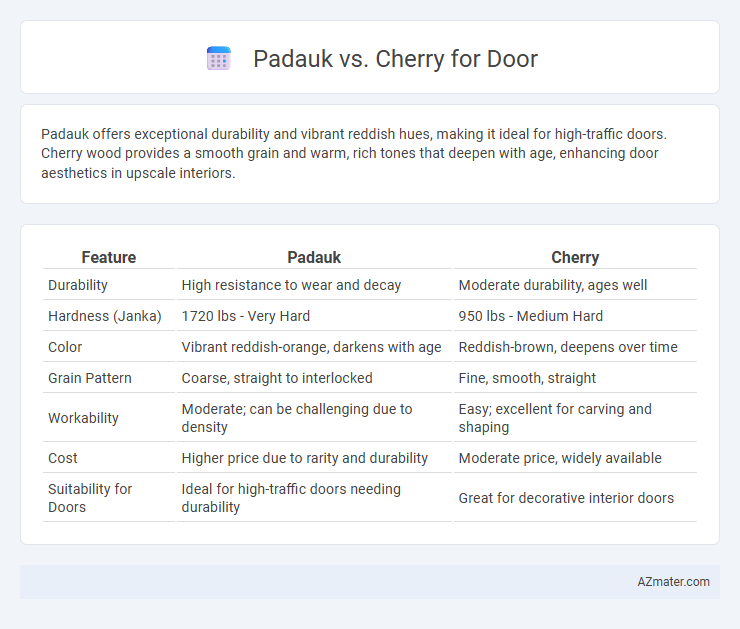Padauk offers exceptional durability and vibrant reddish hues, making it ideal for high-traffic doors. Cherry wood provides a smooth grain and warm, rich tones that deepen with age, enhancing door aesthetics in upscale interiors.
Table of Comparison
| Feature | Padauk | Cherry |
|---|---|---|
| Durability | High resistance to wear and decay | Moderate durability, ages well |
| Hardness (Janka) | 1720 lbs - Very Hard | 950 lbs - Medium Hard |
| Color | Vibrant reddish-orange, darkens with age | Reddish-brown, deepens over time |
| Grain Pattern | Coarse, straight to interlocked | Fine, smooth, straight |
| Workability | Moderate; can be challenging due to density | Easy; excellent for carving and shaping |
| Cost | Higher price due to rarity and durability | Moderate price, widely available |
| Suitability for Doors | Ideal for high-traffic doors needing durability | Great for decorative interior doors |
Introduction to Padauk and Cherry Wood
Padauk wood, sourced primarily from the African and Southeast Asian Pterocarpus trees, is known for its vivid reddish-orange hue and exceptional durability, making it a popular choice for doors requiring both aesthetic appeal and strength. Cherry wood, harvested from the American Black Cherry tree (Prunus serotina), features a rich, warm reddish-brown color that deepens with age, prized for its smooth grain and fine texture in high-end door craftsmanship. Both woods offer distinct characteristics: Padauk excels in hardness and natural resistance to decay, while Cherry delivers elegance and a classic finish favored in traditional and contemporary door designs.
Key Characteristics of Padauk Wood
Padauk wood, known for its vibrant reddish-orange hue, offers exceptional durability and resistance to decay, making it a superior choice for doors compared to cherry wood. Its dense grain structure provides enhanced strength and stability, reducing warping and ensuring long-lasting performance under varying weather conditions. Padauk's natural resistance to insects and moisture adds functional benefits while its striking color deepens to a rich reddish-brown over time, giving doors an attractive and unique appearance.
Unique Qualities of Cherry Wood
Cherry wood is prized for its rich, warm reddish-brown hue that deepens gracefully over time, enhancing the aesthetic of doors with a natural elegance. It features a fine, straight grain with a smooth texture, providing a refined surface that takes stain and finish exceptionally well. Known for its durability and resistance to warping, cherry wood offers both beauty and long-lasting strength ideal for high-quality door construction.
Color and Aesthetic Comparison
Padauk wood exhibits a vibrant, deep reddish-orange hue that intensifies over time, creating a bold and exotic aesthetic for doors. Cherry wood offers a warm, rich reddish-brown color that darkens gracefully with age, providing a classic and elegant appearance. The striking, vivid color of Padauk contrasts with Cherry's smooth, subtle tones, making Padauk ideal for statement pieces while Cherry suits traditional, refined interiors.
Durability and Strength Differences
Padauk wood offers superior durability compared to Cherry, exhibiting excellent resistance to decay, insects, and moisture, making it ideal for high-traffic doors. Cherry wood, while aesthetically appealing with its fine grain and warm tone, is softer and less resistant to dents and wear over time. Padauk's higher Janka hardness rating around 1725 lbf surpasses Cherry's approximately 950 lbf, reflecting greater strength and long-term resilience in door applications.
Workability and Ease of Finishing
Padauk offers excellent workability with its moderate density and fine grain, making it easy to plane, sand, and shape for door applications. Cherry wood is known for smooth machining and sanding due to its straighter grain and consistent texture, which enhances ease of finishing. While both woods accept stains and finishes well, Cherry tends to produce a more even finish with less blotching compared to Padauk's sometimes uneven absorption.
Resistance to Weather and Pests
Padauk wood exhibits excellent resistance to weather conditions and insect attacks, making it highly durable for exterior doors exposed to moisture and varying temperatures. Cherry wood, while aesthetically pleasing with its smooth grain, is less resistant to pests and weather, requiring more maintenance and protective finishes to prevent damage. The natural oils and dense grain structure of Padauk contribute to its superior longevity in outdoor environments compared to Cherry.
Cost and Availability
Padauk offers a vibrant reddish hue with moderate cost and reasonable availability, making it a popular choice for door fabrication in regions where it grows abundantly, primarily in Africa and Asia. Cherry wood, prized for its rich, warm tones and smooth grain, tends to be more expensive due to its slower growth rate and higher demand, with availability concentrated in North America. Both woods provide durability for doors, but Padauk may be more cost-effective and accessible, while Cherry commands a premium price reflecting its aesthetic qualities and scarcity.
Best Applications: Padauk vs Cherry Doors
Padauk wood, known for its vibrant reddish-orange hue and exceptional durability, is ideal for exterior doors due to its resistance to decay and insect damage. Cherry wood offers a smooth grain and rich warm tones that deepen over time, making it a preferred choice for interior doors where aesthetic appeal and fine finishing are prioritized. Both woods perform well in door construction, with Padauk favored for heavy-duty, high-exposure environments and Cherry excelling in elegant, indoor settings.
Final Recommendation: Which Wood Is Better for Doors?
Padauk offers superior durability and vibrant reddish-orange hues that enhance door aesthetics, while Cherry provides a rich, warm tone with smooth grain patterns ideal for traditional styles. Both woods resist wear well, but Padauk's higher density and natural oils give it better resistance to moisture and insect damage, making it more suitable for exterior doors. For longevity and outdoor durability, Padauk is the better choice, whereas Cherry suits interior doors where elegance and fine finishing are prioritized.

Infographic: Padauk vs Cherry for Door
 azmater.com
azmater.com